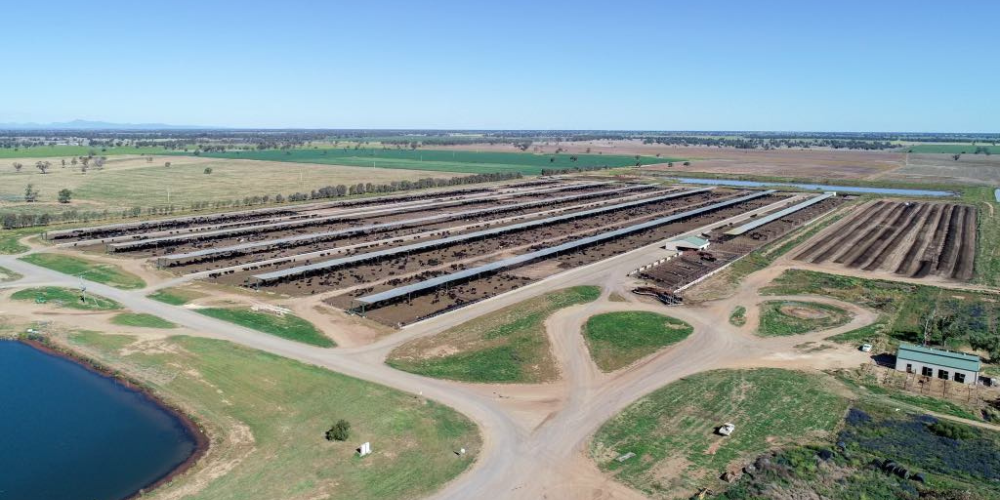Coonamble Feedlot expansion flagged
Coonamble Times
05 April 2024, 8:40 PM
 Angus Chadwick updates council and community members on plans for Coonamble Feedlot PHOTO: River McCrossen
Angus Chadwick updates council and community members on plans for Coonamble Feedlot PHOTO: River McCrossenA future expansion of occupancy at the Coonamble Feedlot was flagged again last month, two years after it was first floated with Coonamble Shire Council.
At the March 2024 meeting council approved a Development Application (DA) with extra conditions attached, for the construction of an additional 26 pens and supporting infrastructure, at the Quambone Road facility.
The approval for the extra pens allows for rehabilitation and ongoing repairs to existing yards, but does not allow for extra stock numbers at this time.
Coonamble Feedlot representative Angus Chadwick took the opportunity to advise council that they have continued to work behind the scenes on the many pieces of the puzzle required to bring an operational expansion to fruition.
The proposal was well received by all councillors back in May 2022 so the Chadwick family have proceeded with their investigations.
At the meeting councillors were advised that it is now likely that the feedlot will look to aim for approval for a maximum of 30,000 head rather than the 20,000 mooted two years ago.
"Like all businesses, the feedlotting sector has enormous headwinds with the rising costs of energy, labour, machinery and insurances," Mr Chadwick told the meeting.
"In order to remain competitive in the sector and run a viable business, we are pushed further towards the need to expand almost just to keep up with our competition."
He cited their power bill at $100,000 per year power bill, even after their company invested in a 99 kilowatt solar system, and Rotomix feed trucks with a purchase price that has ballooned from $200,000 to almost $700,000, and the feedlot requires three of these to operate efficiently.
"These crippling increases in overheads are industry wide, with many yards having either expanded already or going through the same application process that we are.”
"The usual fundamentals of supply and demand still exist and always will, however the only thing that will ensure the business remains viable and relevant is to get control of our overheads by way of expanding and spreading the costs over more cattle. "

The Coonamble Feedlot is looking to grow. IMAGE SUPPLIED.
Mr Chadwick explained that, along with demand for around 100,000 tonnes of grain and about 90,000 cattle per year, the feedlot would generate substantial growth in local employment.
He said it will be "a huge benefit to the Coonamble district with around 1.5 extra jobs created in town for each person out at the feedlot."
"If levels of employment increase by 28 people at the proposed 30,000 head occupancy, this would equate to 42 additional jobs created in the Coonamble shire, 84 jobs in our region and 146 jobs across the state of NSW."
The overall expansion would need to meet stringent state planning standards and will be subject to rigorous assessment.
Councillors raised questions about the availability of water and impacts on odour if the feedlot carries triple the number of stock than currently allowed.
"We do need more water, and we're actively working on that," Mr Chadwick said. "ultimately, you have to have the water before they'll approve a licence."
"The Surat Basin is a lowly-traded aquifer because we don't have the irrigation where you see more water traded, so that's definitely taking longer than expected to attain the water."
The amount of water required would bring the feedlot's take to 800 megalitres per year.
Mr Chadwick said the matter of odour is the primary reason that the proposed capacity was not increased further.
He said a Queensland company who specialises in odour modelling has been engaged.
“Due to the rigorous and expensive application process, it became obvious that we needed to maximise the occupancy so that there wasn’t a future need to go through the process again. Odour models are being completed in accordance with the EPA technical framework, using data received from the Coonamble Airport weather station.
"Our family has lived here for six generations now and with the next generation on the ground, we don’t have intentions on leaving so our primary concern is for minimising any negative impacts and maximising the benefits to the local community."
"Modelling suggested that 35,000 to 40,000 head would be okay from an odour viewpoint, however we decided to reduce it to 30,000 head minimise impact to the community. 30,000 head will have a very similar footprint to the current operations odour footprint.
It is likely that the approvals process could take another 6 months. During that time information will be provided to the community with opportunity for feedback.



